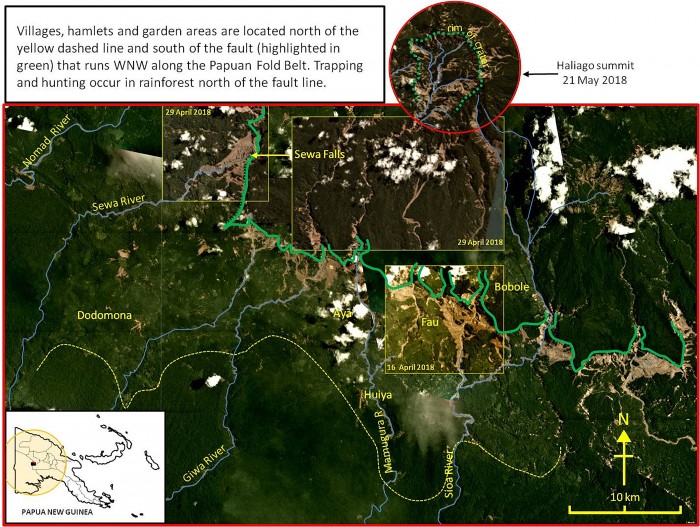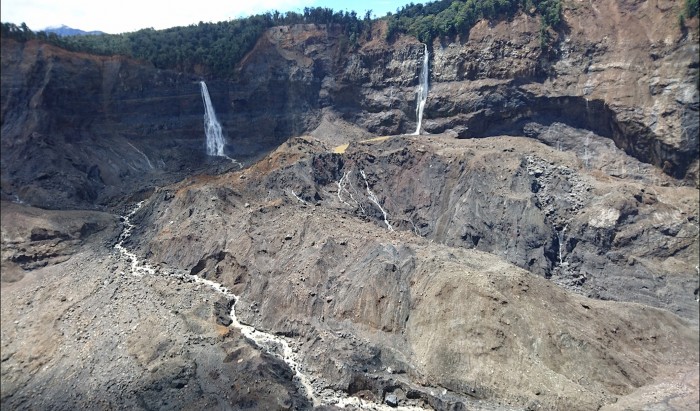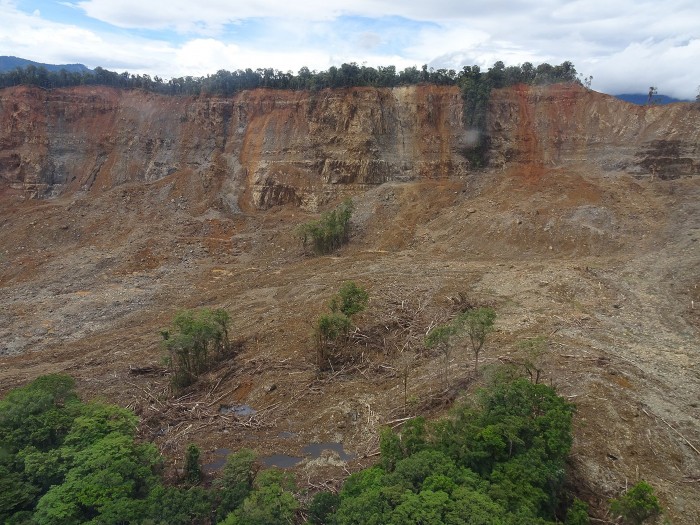All the land customarily used and occupied by the Edolo people of Papua New Guinea (PNG) has been devastated by the swarm of earthquakes that commenced in late February 2018. Few outsiders, however, would be aware of that disaster. With media coverage of events in PNG soon deflected to “bigger” issues of money and the politics of resource extraction, the physical destruction wrought by the quakes has disappeared from view.
On 26 February 2018, a magnitude 7.5 earthquake struck the Papua New Guinea Highlands. The epicenter was 23 kilometers deep and located in the Karius Range, about 10 kilometers south of the conditioning plant associated with the PNG Liquefied Natural Gas (LNG) project. Airstrips, roads, and bridges were damaged, houses collapsed, many food gardens were buried under landslides, more than 140 people were killed, and thousands needed immediate assistance with access to clean water, food, and shelter (Chandler 2018a; Main 2018; Nalu 2018; Zahirovic et al. 2018).
For days, access to the affected region was limited and news was patchy. Social media provided more information than did corporate media. In Australia and elsewhere, the disastrous event, and the hundreds of aftershocks that followed, received only fragmentary coverage. Indeed, it often seemed that the focus was with damage to PNG LNG infrastructure, with the fact that ExxonMobil had closed its plant and declared a force majeure on exports. Cynics could imagine that there had been too few deaths, with none to international citizens, to warrant concerns that reached beyond immediate and long-term financial implications.
Through the next six weeks, many organizations and people devoted huge efforts to providing relief (Glass 2018a). The Australian and New Zealand air forces distributed relief food and the wherewithal to make temporary accommodation or facilitate access to potable water. Oil Search—a company with a 100-year history in PNG, and a major shareholder in the PNG LNG project—committed more than 16 million kina to the relief effort and provided much-needed medical support to more than 42 villages. Ok Tedi Mining Limited (OTML) provided 50 million kina to help restore services and infrastructure in impacted communities and, for several weeks, provided helicopter support to a group of mission-linked people who assisted at remote communities in Western Province, Hela Province, and Southern Highlands Province. Mission Aviation Fellowship provided many flights to tiny airstrips, delivering relief supplies and, as necessary, helping with medical evacuations. In Port Moresby, the National Disaster Management Office provided a coordinating role, though, given the parlous state of the PNG economy, this organization, like many others, was strapped for funds.
In mid-April, both Oil Search and ExxonMobil announced that production of oil and gas would soon resume, weeks ahead of an expected delay, and global media attention turned to the seemingly bright future of the petroleum industry in PNG. Two weeks later, Jubilee Australia released a detailed comparison of “the projected benefits for the early years of the PNG LNG project with the actual outcomes.” The project had been predicted to double the gross national product of PNG and have numerous flow-on benefits with respect to household incomes, employment, education, health, law and order, and infrastructure. However, two years after exports of gas commenced, there were declines in all these variables. The conclusion was blunt: “Currently, on almost every measure of economic welfare in 2016, PNG would have been better off without the PNG LNG project” (Flanagan and Fletcher 2018: 5).
Both the PNG LNG project’s resumption of production and Jubilee Australia’s detailed critique of that project captured international attention (Blades 2018; Chandler 2018b; Ludlam 2018). PNG Prime Minister Peter O’Neil declared the report to be “fake news.” The competence of the PNG government was challenged. The reputation of big petroleum companies was at stake. News of the earthquakes and their consequences took second place to commentary on economic matters. The Jubilee report did not mention the earthquakes. In some ways, its timing was unfortunate. It redirected attention from the needs of people traumatized by a natural disaster to the economic failings of government. It set the scene for directing blame at the petroleum companies. It seemed that those companies were somehow responsible for the financial woes of the PNG government, for the failure of royalties to reach deserving landowners, for the lack of development in Hela Province where Huli people hosted the PNG LNG project, and—perhaps, in the understanding of many of those people—for the earthquakes that have devastated their land. The petroleum companies had broken the ground by removing its store of gas.
In this brief report, we turn away from PNG LNG, and from the 200,000-plus so-visible, so-outspoken, and often so-demanding Huli, to refocus attention on the earthquakes themselves. In what follows, we illustrate the effects of those earthquakes on the land of a few thousand people who live across mountains to the southwest of the wells that supply gas to markets in China, Japan, and South Korea. The people are Edolo.

Edolo: The People and Their Land
The land of the Edolo people comprises the southern and southwestern slopes of Mount Haliago, from the Sioa River in the east to the Sewa River in the west. Here, nearly three thousand people live in about 20 villages where they garden, tend orchards of fruit pandanus, and process the starch from sago palms at altitudes of 600 to 1,000 meters above sea level (see Figure 1). These places are located immediately south of a prominent fault line that runs WNW across the land as a conspicuous escarpment spanning altitudes from 1,000 to 1,200 meters. At higher altitudes, to the summit of Haliago at 2,689 meters, the land is densely forested. It is home to a rich fauna of birds and mammals and, for Edolo people, is a domain of trapping and hunting (Dwyer 1990; Kelly 1977).
The largest Edolo communities are at Bobole, in the east, and Dodomona, in the west. Both have populations of three hundred to four hundred people. There are small airstrips, usually serviced by Mission Aviation Fellowship, at Dodomona, and the centrally situated community of Huiya. Onabasulu people live to the southeast of Edolo land, Kaluli to the south across the Great Papua Plateau on the lower northern slopes of Mount Bosavi, and Bedamuni to the west across Sewa River toward the Strickland River. People of all these language groups live as small, scattered communities whose access to the outside world is via tiny airstrips, mission-supported radio, and, since 2011, limited mobile phone coverage. For all Edolo people, access to the “modern world” entails a 20-kilometer walk across steep mountains and through beautiful moss forest, northeast from Bobole to the always-busy Huli town of Komo, a center of PNG LNG activities.
And then the earthquakes came. Within six weeks of the late February quake, there were more than two hundred aftershocks with a magnitude of 4 or higher. The epicenter of more than 20 of these were within Edolo territory. There were terrifying landslides everywhere (see Figure 1). The inner walls of the Haliago crater collapsed, and earth, rocks, and vegetation spilled into the upper watershed of Mamugura River. Landslides tumbled into the upper reaches of all the rivers that radiate from Haliago or drain the western slopes of the Karius Range—Sioa, Mamugura, Giwa, Sewa, Giluwe (Nomad), and, further north, Baiya. Where these rivers cut through the fault of the Papuan fold belt or, as with Sewa River, plunge over a precipitous escarpment, there were more landslides. One buried 11 men, women, and children who slept in a house near Fau, four of whom were on their way from Aya to Komo in the highlands and chose to stay overnight with friends and relatives (Chandler 2018a). And everywhere, south of the fault line, there were more landslides that buried gardens and wiped out thousands of hectares of forest.


People were traumatized. They did not understand the cause of the quakes. They did not know when the quakes would cease. At night, as they tried to sleep, they could hear the land falling apart. Houses collapsed. People were injured. Many gardens were destroyed. Travel was dangerous because the threat of more landslides was the new normality. Gradually, they found their way to Huiya and Dodomona, swelling populations at both villages from a few hundred to 1,400 people. They abandoned former hamlets and villages in favor of the two places where it was possible to communicate with the outside world, to let others know of their plight. They became refugees on their own land, supported by the generosity of the residents of Huiya and Dodomona who themselves had been so badly affected by the quakes. They were supported too by a small team of volunteers, based at the Bedamuni village of Mougulu, who, with the support of helicopter transport provided by OTML, monitored the needs of, and organized relief for, remote communities of the Western, Hela, and Southern Highlands provinces (Glass 2018b).
Coda
On the night of 7 March, an earthquake of magnitude 6.7 wrought yet more havoc on the land. The epicenter was between Huiya and Dodomona. People who had assembled at Huiya fled their temporary shelters. They gathered on the airstrip, seeking a surface that might be safe. Sally Lloyd was with them. She wrote: “I have never been more thankful for a remote airstrip than the night of a second big earthquake . . . right under Huiya.” She too spent “the dark night listening to the mountains and forest fall.” She saw the fear on people’s faces, “the terror as they tried to escape.” She was there the next day when Mission Aviation Fellowship flew in “to evacuate the injured” and then closed the airstrip because it too was now seriously damaged.
In a Post Courier editorial of 29 May 2018 titled “Revisiting the Earthquake Devastated Communities,” the writer commented: “It is true that Papua New Guineans are resilient in restoring their lives following devastating natural disasters, but this is not so for many as well. Always forgotten and now neglected there are some communities in the outbacks of Southern Highlands, Hela and Western provinces that might just not make it.”
In the land of the Edolo people and their Bedamuni neighbors, there is a myth that tells of the end of the world, when earthquakes will come and the waterfall at Sewa River will collapse (Dwyer and Minnegal 2000). The earthquakes have come. The waterfall has collapsed. The land is devastated. And the people are left wondering and waiting. Have they, once again, been “forgotten” and “neglected” by a government that is spending vast sums of money (which it may not even have) to host an Asia-Pacific Economic Cooperation forum? Have they, once again, been “forgotten” and “neglected” by a government that is contemplating banning Facebook when that medium proved critical in relaying urgent messages of damage, deaths, and desperate need from remote locations to places where at least some people and organizations were willing to listen and able to assist?
Monica Minnegal is Associate Professor of anthropology in the School of Social and Political Sciences at the University of Melbourne. Peter Dwyer is Honorary Senior Fellow in the School of Geography at the University of Melbourne. Since 1986, they have conducted research among Kubo, Febi, and Bedamuni people of Western Province, Papua New Guinea, with a particular emphasis on social change and, most recently, impacts of the PNG LNG project on people’s lives. Their book Navigating the Future: An Ethnography of Change in Papua New Guinea was published in 2017 by Australian National University Press.
References
Blades, Johnny. 2018. “PNG Govt Defends Gas Project but Landowners Grow Restless.” Radio New Zealand, 3 May.
Chandler, Jo. 2018a. “Enormous Challenges Confront Papua New Guinea after Earthquake.” Sydney Morning Herald, 1 March.
Chandler, Jo. 2018b. “Papua New Guinea’s Resource Curse: Disaster Strikes the Nation’s Massive Gas Project.” The Monthly, May 2018.
Dwyer, Peter D. 1990. The Pigs That Ate the Garden: A Human Ecology from Papua New Guinea. Ann Abor: University of Michigan Press.
Dwyer, Peter D., and Monica Minnegal 2000. “El Niño, Y2K and the ‘Short, Fat Lady’: Drought and Agency in a Lowland Papua New Guinean Community.” Journal of the Polynesian Society 109, no. 3: 251–272.
Glass, Mandy. 2018a. “Actions of Hope and Relief amidst the Devastation.” Mission Aviation Fellowship, accessed 8 June. http://www.maf-papuanewguinea.org/actions-of-hope-and-relief-amidst-the-devastation.
Glass, Mandy. 2018b. “Joy on the Ground: Delivering Aid and Repatriating Patients into the Earthquake-Stricken Area.” Mission Aviation Fellowship. accessed 8 June. http://www.maf-papuanewguinea.org/joy-on-the-ground.
Flanagan, Paul, and Luke Fletcher 2018. Double or Nothing: The Broken Economic Promises of PNG LNG. World Square, NSW: Jubilee Australia Research Centre.
Kelly, Raymond C. 1977. Etoro Social Structure: A Study in Structural Contradiction. Ann Arbor: University of Michigan Press.
Ludlam, Scott. 2018. “ExxonMobil’s Project in PNG Is Economic Parasitism.” The Guardian, 2 May 2018.
Main, Michael. 2018. “How PNG LNG Is Shaking Up the Earthquake.” EnviroSociety, 28 March. www.envirosociety.org/2018/03/michael-main-how-png-lng-is-shaking-up-the-earthquake.
Nalu, Malum. 2018. “Villagers Vigilant as Aftershocks Continue.” The National Weekender, 9 March.
Zahirovic, Sabin, Gilles Brocard, John Connell, and Romain Beucher 2018. “Aftershocks Hit Papua New Guinea as It Recovers from a Remote Major Earthquake.” The Conversation, 9 April.
Cite as: Dwyer, Peter D., and Monica Minnegal. 2018. “Refugees on Their Own Land: Edolo People, Land, and Earthquakes.” EnviroSociety, 9 June. www.envirosociety.org/2018/06/refugees-on-their-own-land-edolo-people-land-and-earthquakes.
